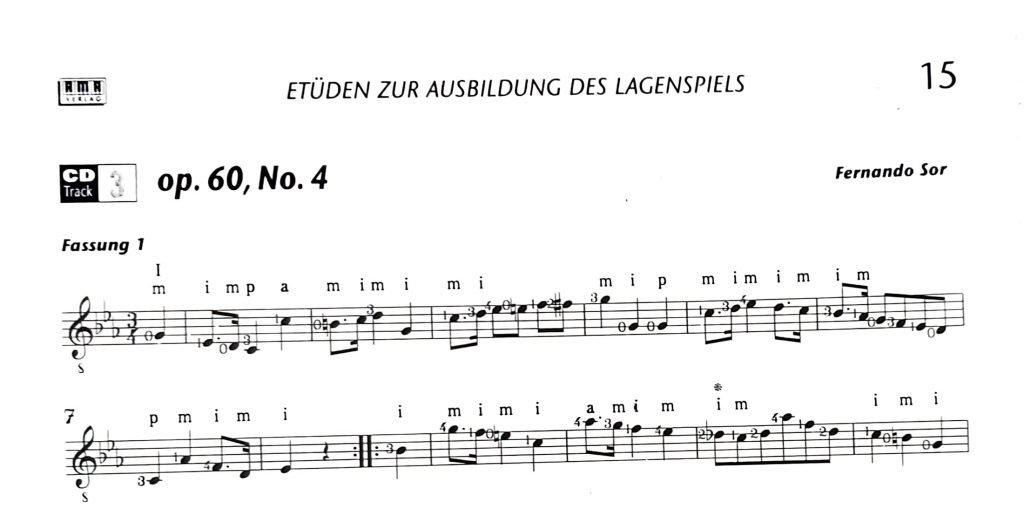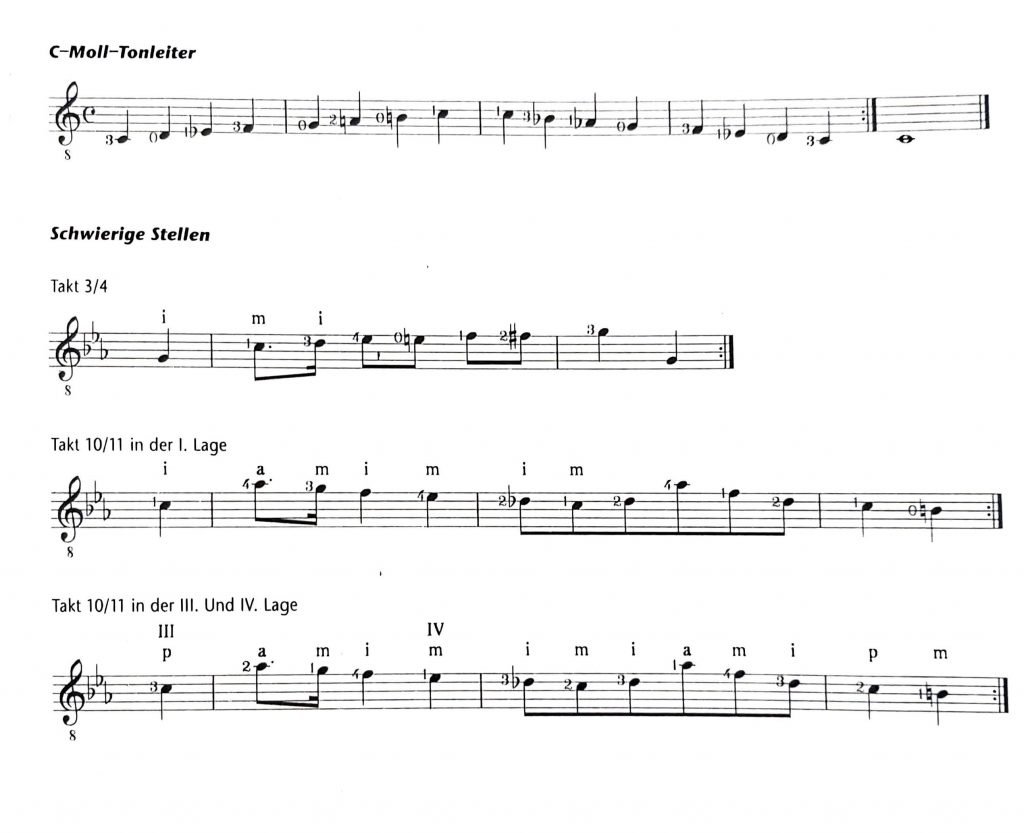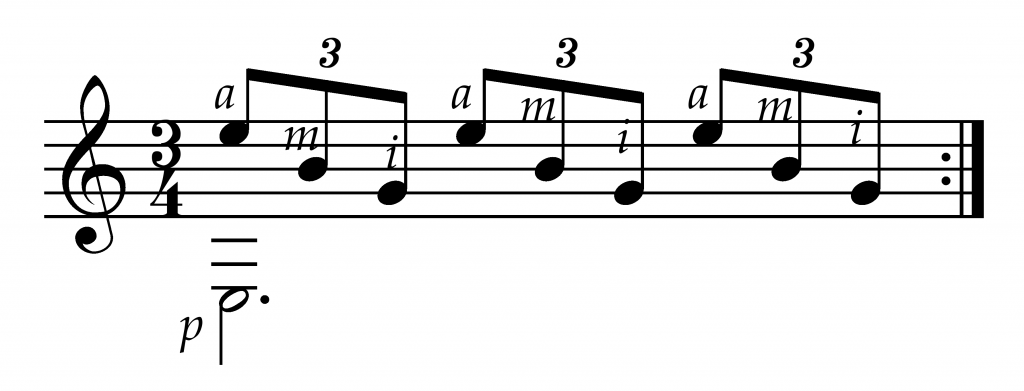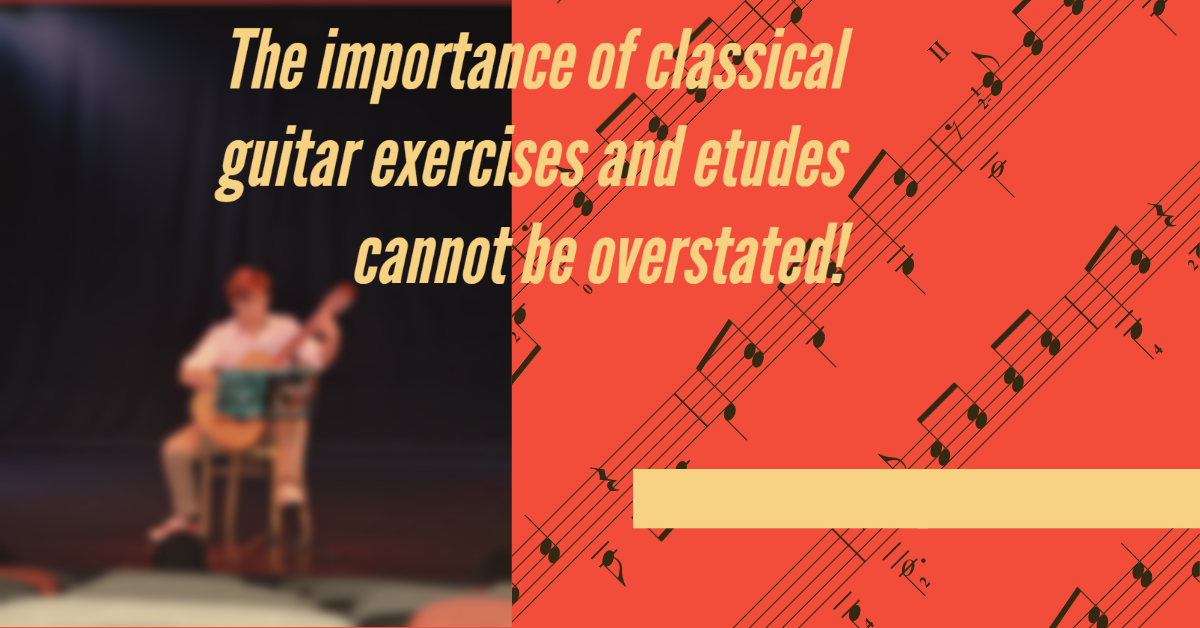As classical guitar players and students, we constantly improve our technique and our interpretation skills. One of the most common ways to do that is by playing guitar exercises and etudes. During centuries of the development of the classical guitar, composers and teachers have created a massive amount of didactic literature. For different situations aiming to cultivate certain skills and techniques. In this article, I will try to explain what the difference between exercises and etudes is. As well as when to use exercises and when to use etudes to improve your performance skills.
What is a guitar exercise?
in a broad sense, an exercise is a small piece of music that often does not have musical meaning. The purpose of an exercise is to introduce some technique or to improve the one that is already mastered. For example, just playing the first string with your right-hand index finger multiple times is an exercise. Playing p, i, m, a, arpeggio on open strings or using some chord progression is also an exercise. See below (fig.1) an example of an exercise from my online Classical Guitar Course for Adults Level 1
fig.1

The purpose of this rhythm exercise is to teach the student to alternate their index and middle fingers. There are instructions on how the student can use it to develop the right-hand thumb as well.
This exercise can work on improving tone quality, right-hand articulation, dynamics, rhythm, and many more. It depends on the current situation and what the student needs.
A technical guitar exercise
can be also in a form of a small musical phrase or a tiny part of a musical piece or etude where you or your teacher can explore different possibilities of practicing it. It can be practiced being learned as a part of the piece that you are working on now. Also, you can practice it just as a technical exercise to improve certain techniques.
Hubert Käppel in his “Die 33 wichtigsten Gitarrenetüden für die Unterstufe” extracts on a separate page the most difficult places and organizes them as small exercises that the student can practice separately out of the context of the etude. He also gives a scale for each etude.
Here is the Fernando Sor (1778 -1839) op. 60, No. 4, as an example, of Hubert Keppel’s approach:
Fig. 2 is an extract from the etude itself. The fingering is pointed very reach so the student or the teacher to concentrate on their tasks rather than creating and experimenting with fingerings.
Fig. 2

Here (fig. 3) is the Scale C melodic minor. It is easy for both, the teacher, and the student to look at the scale to play it remember it, analyze it, etc. even prior to playing the etude.
fig.3

Difficult Spots
The scale is followed by Schwierige Stellen (difficult spots) das making it so comfortable for the guitar student to concentrate on the difficulties right away. The spots are not just randomly cut from the whole etude. They are extracted in a way that makes some musical sense too. He (Kappel) mentioned also from the which-to-which bar are those extractions. The second exercise is from bars 10 and 11 in the first position. While the third exercise consists of the same bars 10-11 but in position III moving to position IV.
Those let’s call them, exercises are much more interesting and fun to play and learn. Such an approach is extremely effective. Rather than playing the etude from beginning till end.
What is an etude?
On the other hand, an etude is already a musical piece. It also serves as an exercise. It is composed not only with the agenda of solving technical problems but also shaped as a musical piece. Some etudes are also called: “Concert Etudes”. The guitarists use such etudes to build their technique as well as a part of their concert repertoire. For example Heitor Villa-Lobos (1887-1959) Twelve Études for Guitar. You can read more about what is etude here
Example of how guitar exercises and etudes can help you to learn a piece.
Let us say we are learning Vicente Gomez (or Anonimous) “Romance de Amor” it is a very well-known guitar piece. Almost every guitarist and guitar student play this piece at some point in their career. You can watch the beautiful interpretation of this great piece by Konstantin Levin.
It will be great if we just take the guitar and play the Romance just like Konstantin. What are the technical problems in this piece? There are many. But I will concentrate only on the right hand, for the sake of the example and the point that I am trying to make in this article.
Right-hand technique
The right-hand technique in this piece is arpeggio “a, m, i,” in triplets while in the first beat of each bar there is a base at the same time with the “a” finger. The following two beats in each bar are only “a, m, i,” arpeggio. The a, m, and i fingers will be playing always on strings 1, 2, and 3 throughout the whole piece. See below (fig.3) a small part of the piece.
fig.4

So, the right-hand technique that we will need to acquire and master is this particular arpeggio. We need to be able to sustain it for as long as it takes, to be easy, comfortable, fluent, even, under control, and so on.
Here comes the fragmental approach that I like to use in my teaching and I guess most teachers do. The first thing we need to do is to take this arpeggio out of context and break it down in the shape of a simple exercise. Purely on a mechanical level. At this stage we will ignore the base we will take only the “a, m, i” movement. The first technical exercise may look like this: (fig.5)

With this guitar exercise, we can aim for a few things:
- just to acquire the “a, m, i,” movement with all posture and mechanical requirements. You can lay your thumb on strings 6, 5, or 4 wiles playing the exercise or keep it in the air, all depends on what are our issues at the moment with this arpeggio.
- The next stage will be to make those notes even in length and loudness.
- We may try now to expose more the “a” finger, as the main melody of the piece is on string 1. and make the middle and index softer and so on. There are many things that we can do with it but let’s stop here.
The next Guitar exercise
will be to add the base on the first beat (fig.6) and practice it until it becomes easy enough.
fig.6

Playing an etude
Now that we are well familiar with the arpeggio through the above exercises, it might be a good idea to find and practice an etude. The etude should involve the same arpeggio, and should be relevantly short. The purpose of that is to test and experience the new technique in something more real than just an isolated exercise. That is the role of an etude to prepare us for something bigger as well as to affirm the technique that we have learned. It can be used also to maintain that technique. Below (fig.7) is a part of Francisco Tarrega (1852-1909) “Estudio en mi menor”.
fig.8

This etude is a great milestone in the way to Romance de Amour.
In Conclusion
We use guitar exercises to learn, examine and digest the new techniques and concepts. In the next stage, we use etudes to implement those techniques in musical examples. Finally, we play a piece that includes this technique. This process is not always as simple as it looks but in general, this is the idea.
